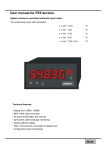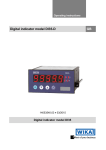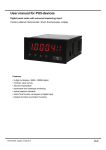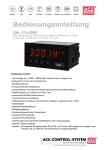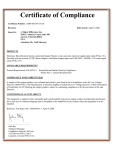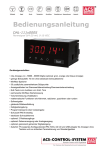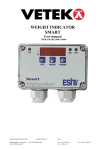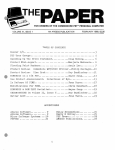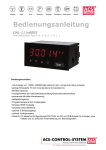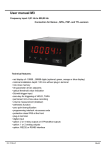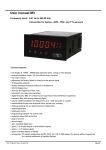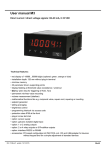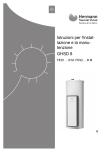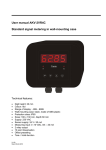Download Manual - Montwill
Transcript
User manual for PZ5 devices Digital processor controlled arithmetic panel meter: Two voltage/current inputs: x = (In1 + In2) * K x = (In1 - In2) * K x = (In1 * In2) * K x = (In1 / In2) * K x = (In1 * 100 / In2) * K Technical features: • red 5-digit display (-9999…99999) • min/max value recording • 30 points linearisation per channel • permanent cable breakage monitoring • optical switching point display • Hold-function/Tara-function via keypad or digital input • configurable channel switching PZ5X1DDGB.pdf update: 20.11.2015 96x48 Contents Contents 1. Identification…………………………………………………………………………….….. 2 2. Technical data……………………………………………………………………………... 3 3. Safety advices……………………………………………………………………..…….… 5 4. Assembly…………………………………………………………………………………… 6 5. Electrical connection…………………………………………………………………........ 7 6. Operation and function description………………………………………...………..…... 10 6.1 Operation……………………………………………………………………….……… 10 6.2 Alarms / Relay………………………………………………………………….…..… 13 6.3 Analog output……………………………………………………………………….... 15 6.4 Digital input / Zero-key………………………………………………………………. 15 6.4.1 Hold-Function……………………………………………………………….… 15 6.4.2 Tara-Function……………………………………………………………….… 16 6.4.3 Configurable channel switching ………………………………………….… 16 6.5 Interface RS232 / RS485……………………………………………….......……… 16 7. Programming…………………………………………………………………........……… 17 8. Program number description…………………………………………………………..... 22 8.1 Program number table…………………………………………………...........….… 26 9. Reset to default values………………………………………………………………...…. 30 10. Error elimination………………………………………………………………………...…. 31 1 1. Identification 1. Identification STANDARD TYPES ORDER NUMBER Supply 100-240 VAC 50/60 Hz, DC ±10% PZ5.0301.1S70D Supply 10-40 VDC, galv. isolated, 18-30 VAC 50/60 Hz PZ5.0301.1W70D Options – decoding of the ordering code: P Z 5. 0 3 0 1. 1 S 7 0 D Standard device type Internal Index D Two standard signal inputs Version D Z Switching points 0 2 4 Number of digits 5 5-digit no switching point 2 relay outputs 4 relay outputs Interface none RS232 (galv. isolated) RS485 /galv. isolated) 0 3 4 Mechanical options 7 IP65, foil keypad, plug-in terminal Voltage supply S W Sensur supply 3 24 V / 50 mA Outputs 100-240 VAC 10-40 VDC Housing size none 0-10 V, 0-20 mA, 4-20 mA 0 X 1 96x48 mm Measuring input 1 0-10 VDC, 0/4-20 mA Dimension signs on demand, please state with order, e.g. m/min. 2 2. Technical data 2. Technical data Housing Dimensions 96x48x120 mm (BxHxD) 96x48x139 mm (BxHxD) including plug-in terminal Panel cut-out 92.0+0.8 x 45.0+0.6 mm Wall thickness up to 15 mm Fixing screw elements Material PC Polycarbonate, black, UL94V-0 Protection class standard IP65 (Front), IP00 (Back side) Weight approx. 350 g Connection Screw clamp/plug-in terminal; line cross section up to 2.5 mm2 Display Digit height 14 mm Segment colour red Range of display -9999 to 99999 Switching points 1 LED per switching point Overflow horizontal bars at the top Underflow horizontal bars at the bottom Display time 0.1 to 10 seconds Input Measuring range 0…10 V and 0/4…20 mA Input resistance 0…10 V RI = ~ 150 kΩ 0/4…20 mA RI = ~ 50 Ω Measuring error at measuring time = 1 sec 0.02 % of measuring range ± 1 Digit TU = 20…40°C Temperature drift at TU < 20°C bzw. > 40°C all measuring inputs 50 ppm/K Measuring time 1 channel 0.02 …10.00 seconds 2 channels 0.04 …10.00 seconds Measuring principle Sigma / Delta Resolution 24 bit Digital input <2.4 V OFF, >19 V ON, max. 30 VDC, Ri ~ 5 kΩ 3 2. Technical data Output Relay Switch-over contact 230 VAC / 5 A; 30 VDC / 2 A at ohm resistive load Switching cycles 0.5 * 105 at max. contact load 5 * 106 mechanically Separation as per DIN EN 50178 / characteristic data as per DIN EN 60255 Output Analog output 0/4-20 mA / load ≤ 500 Ω 0-10 VDC / load ≥ 10 kΩ, 16 bit Error 0.1 % % in the range TU= 20...40°C, beyond 50 ppm/K Sensor supply (galv. isolated) 24 VDC, 50 mA Interface Protocol manufacturer-specific ASCII RS232 (optional galv.isolated) 9600 Baud, no parity, 8 databits, 1 stopbit , ASCII protocol Lead length max. 3 m RS485 (galv. isolated) 9600 Baud, no parity, 8 databits, 1 stopbit , ASCII protocol Lead length max. 1000 m Power Pack Supply voltage 100-240 VAC / 50/60 Hz, DC ±10 % (max. 15 VA) 10-40 VDC, galv. isolated, 18-30 VAC 50/60 Hz (max. 15 VA) Memory Parameter memory EEPROM Data life ≥ 100 years at 25°C Ambient conditions Working temperature 0...50°C Storing temperature -20...80°C Climatic density rel. humidity ≤75 % on years average without dew EMV DIN 61326 CE-sign conformity to directive 2004/108/EG Safety standard according to low voltage directive 2006/95/EG, EN 61010, EN 60664-1 4 3. Safety advices 3. Safety advices Please read the users guide and chapter 4 before installation and keep it for future reference. Proper use The PZ5 is designed for the evaluation and presentation of transmitter signals (standard signals). With the set points, it is possible to perform simple control tasks . Caution! Careless use or improper operation can result in personal injury and/or damage of the equipment! Control of the device The panel meters are checked before dispatch and sent out in perfect condition. Should there be any visible damage, we recommend close examination of the packaging. Please inform the supplier immediately of any damage . Installation The PZ5 must be installed by a suitably qualified specialist (e.g. with a qualification in industrial electronics). Notes on installation • There must be no magnetic or electric fields in the vicinity of the device, e.g. due to transformers, mobile phones or electrostatic discharge. • The fuse rating of the supply voltage should not exceed a value of 6A N.B. fuse. • Do not install inductive consumers (relays, solenoid valves etc.) near the device and suppress any interference with the aid of RC spark extinguishing combinations or free-wheeling diodes. • Keep input, output and supply lines separate from one another and do not lay them parallel with each other. Position “go” and “return lines” next to one another. Where possible use twisted pair. This way, the best measuring results will be received. • Screen off and twist sensor lines. Do not lay current-carrying lines in the vicinity. Connect the screening on one side on a suitable potential equaliser (normally signal ground). • The device is not suitable for installation in areas where there is a risk of explosion. • Any electrical connection deviating from the connection diagram can endanger human life and/or can destroy the equipment. • Do not install several devices immediately above one another or in an extremely thermal isolated housing. Due to the internal heat dissipation of the decives, the recommended ambient temperature can be excessed. • The terminal area of the device is part of the service. Here electrostatic discharge needs to be avoided. Attention! High voltages can cause dangerous body currents. • Galvanic isolated potentials within one complex need to be placed on an appropriate point (normally earth or machines ground). So, a lower disturbance sensibility against impacted energy can be reached and dangerous potentials, that can occur on long lines or due to faulty wiring, can be avoided. 5 4. Assembly 4. Assembly Please read the Safety advices on page 5 before installation and keep this user manual for future reference. PZ 5 48,0 3,0 Dic htu ng me lem k s s hlu nsc A lich ließ ,0 h c 9 s 13 ein e f utie ba Ein Dimensionsfeld 1. 2. 3. After removing the fixing elements, insert the device. Check the seal to make sure it fits securely. Click the fixing elements back into place and tighten the clamping screws by hand. Then use a screwdriver to tighten them another half a turn. CAUTION! The torque should not exceed 0.1 Nm! The dimension symbols can be exchanged before installation via a channel on the side! 6 5. Electrical connection 5. Electrical connection 7 5. Electrical connection Interface connection The lines for the RS232 interface must be connected 1:1, TxD to TxD and RxD to RxD. Connection pattern PC or SPS ⇔ PZ5 The interface RS485 is connected via a screened data line with twisted wires (Twisted-Pair). A termination of the bus wire must be connected at the end of each bus segments. This is neccessary to guarantee a save data transfer on the bus. Therefor a resistance (120 Ohm) is inserted between the wires Data B (+) and Data A (–). Caution! The potential reference can lead to a compensating current (interface ⇔ measuring input) with a non-galvanic isolated interface and can thus affect the measuring signals. 8 5. Electrical connection Connection examples This section gives a few examples of practical connections. Other connection options can be combined from the various examples: Co-channel measurement with current signals, supply 100-240 VAC: Co-channel measurement with voltage signals, supply 10-40 VDC: One-channel measurement with current signal in combination with digital input and sensor supply, voltage supply 230 VAC: 9 6. Operation and function description 6. Operation and function description 6.1. Operation Display (1) 7 segment display 5-digit, red Digit height 14 mm Display range -9999…99999 Decimal points none, 1, 2, 3, 4 (adjustable) Switching point displays (2) Optical threshold message 4 LED, red Keys (7), (5), (6), and (3) Programming mode Increase of value range Decrease of value range + Address Next lower program number + Address Next higher program number Activation of TARA or HOLD, Reset for Min/Max permanent Dimension gap (4) for physical unit Variable dimension strip Dimension on demand e.g. kg, m³… 10 6. Operation and function description Switching on Before switching on, check all the electrical connections to make sure they are correct. On completion of the installation, the device can be switched on by applying the supply voltage. Starting sequence During the switching-on process, a segment test is performed for approx. 1 second, whereby all LED on the front (including setpoint LED) are triggered. After this, the type of software is indicated for approx. 1 second and then, also for 1 second, the software version. After the starting procedure, the unit changes to operation mode / display mode. MIN/MAX memory The measured minimum and maximum values are saved in a volatile memory in the unit and get lost when the unit is switched off. Call up the contents of the memory by pushing (less than 1 second) the [▲] or [▼] key. The relevant value is indicated for approx. 7 seconds. By briefly pressing the same key again, one will return immediately to the display mode. [▲] ⇒ Display of maximum value [▼] ⇒ Display minimum value Erase the value shown in the display by simultaneously operating the [▲] and [▼] keys. The erasure is acknowledged by horizontal bars. The content of the memory will be lost with switchingoff of the device. Display switch-over between two input channels For the PZ5 device it is possible to switch temporarily between the different channels via keypad. Push the [▼]- or [▲]-key for longer then 1 second, this leads to a switch-over to the next channel. The channels can be run through forwards with [▲]-key or backwards with [▼]-key. Display: Channel 1 Channel 2 Arithmetic Channel 1 Ch1 Ch2 Ar Ch1 and so on... Example: Under program number (PN15≥3) the calculation (Ar) is parameterised as a permantent display. The input value for channel 1 shall be displayed: Push the [▲]-key for at least one second. The PZ5 device acknowledges the change to channel 1 by shortly displaying Ch1, thereupon stop pushing the key. The input value of channel 1 is shown for approx. 7 seconds in the display, then the display changes back to the parameterised display (arithmetic Ar). This operation is confirmed by showing „Ar“ in the display. To recall all channels, the [▲]- or [▼]-key needs to be detached in the meantime. 11 6. Operation and function description Overflow/Underflow of the arthmetic result During the channel calculation the comma (PN18) is included in the calculation as decimal point. Each overflow or underflow of a channel leads in the calculation to a defined display. This defined setting ensures that the corresponding setpoints go into a defined state. Formula Channel 1 Channel 2 Result (Channel 1 + Channel 2) * Constant Overflow OK or overflow Overflow (Channel 1 + Channel 2) * Constant Underflow OK or underflow Underflow (Channel 1 + Channel 2) * Constant OK or overflow Overflow Overflow (Channel 1 + Channel 2) * Constant OK or underflow Underflow Underflow (Channel 1 + Channel 2) * Constant Overflow Underflow Overflow (Channel 1 – Channel 2) * Constant Overflow OK or underflow Overflow (Channel 1 – Channel 2) * Constant Underflow OK or overflow Underflow (Channel 1 – Channel 2) * Constant OK or overflow Underflow Overflow (Channel 1 – Channel 2) * Constant OK or underflow Overflow Underflow (Channel 1 – Channel 2) * Constant Underflow/Overflow Underflow/Overflow Overflow (Channel 1 * Channel 2) * Constant Overflow OK or overflow Overflow (Channel 1 * Channel 2) * Constant Underflow OK or underflow Underflow (Channel 1 * Channel 2) * Constant OK or overflow Overflow Overflow (Channel 1 * Channel 2) * Constant OK or underflow Underflow Underflow (Channel 1 * Channel 2) * Constant Overflow Underflow Overflow (Channel 1 / Channel 2) * Constant Overflow Optional Overflow (Channel 1 / Channel 2) * Constant Underflow Optional Underflow (Channel 1 / Channel 2) * Constant OK Overflow Underflow (Channel 1 / Channel 2) * Constant OK Underflow Underflow (Channel 1 * 100 / Channel 2) Overflow Optional Overflow (Channel 1 * 100 / Channel 2) Underflow Optional Underflow (Channel 1 * 100 / Channel 2) OK Overflow Underflow (Channel 1 * 100 / Channel 2) OK Underflow Underflow Overflow / Underflow Overflow horizontal bars are displayed on the top of the display Underflow horizontal bars are displayed at the bottom of the display 12 6. Operation and function description 6.2 Alarms / Relays An active relay, or an activated switching point is indicated by a flashing of the relevant switching point LED, which you find directly next to the 7-segment display. Functional principle of alarms / relays Alarm / Relay X Channel 1, Channel 2, arithmetic calculation Threshold Switch-over threshold value Hysterisis Width of window between switching threshold Working principle Operating current / quiescent current Switch-on delay Time between reaching the threshold and the resultant switching on of the relay. Swith-off delay Time between reaching the threshold and the resultant switching off of the relay. 13 6. Operation and function description Operating current Relays S1-S4 are off below the threshold and on on reaching the threshold. Quiescent current Relays S1-S4 are on below the threshold and switched off on reaching the threshold. Swith-on delay The relay S1-S4 is on 10 seconds after reaching the threshold; briefly exceeding the threshold does not lead to the relay being switched on. The switch-off delay functions in a similar manner, in other words it keeps the relay switched on until the parameterised time has elapsed. 14 6. Operation and function description Allocation of the alarms to a certain actuate value As it is not always desired that alarms follow the operating mode, the outputs can be assigned to the minimal/maximal value or any other value. Therefor the adjustable value range is assigned to the according program number (PN60, PN70, PN80 and PN90). Alarms 1-4 Mode Actuate value 0 none 1 Channel 1 2 Channel 2 3 Arithmetic function Optical response, flashing display If one or some thresholds are broken, the flashing of the alarm LED can amplify the optical response by assignment of the threshold PN59 to the 7 segment display. Example: The threshold for flashing of the display is set at alarm 2. If alarm 1 is exceeded and alarm 2 is not, the alarm LED 1 lights up permanently. If alarm 2 exceeds the threshold, the 7-segment display will start to flash, alarm 1 will light up permanently and alarm LED 2 will flash. The flashing enhances the optical response and the operator sees immediately that an important threshold has been exceeded with this unit. 6.3 Analogue output The optional analogue output is used for the transduction of a measuring value, supported by a standard signal of 0…10 V or 0/4…20 mA. The analogue output is paramerterised via the two program numbers PN20 final value (fullscale) and PN21 initial value (Offset). At the initial value, the value is set at which the analogue output transmits the minimal value (0 V or 0/4 mA), and at the final value, the value at which the output transmits its maximum (10 V or 20 mA). By this means it is possible to rescale the input signal of a transducer or even to convert it into another standard signal. The analogue output can be set on channel 1, channel 2 or the arithmetic value via the actuate value PN22. The analogue output is updated within the cycle of the measuring time. At a high measuring rate, smaller cycle fluctuations of some milli-seconds are possible. 6.4. Digital input / Zero key In combination with the digital input (via terminal) and/or the zero key at the front, functions like e.g. HOLD, TARA or a channel switch-over, can be actuated. The digital input is available in combination with the option sensor supply or via an external 24 VDC-signal. The zero key at the front of the device can be activated by keypress. 6.4.1 HOLD function The HOLD function is a static or keyed signal and is activated via the digital input or the zero key. It always takes effect on the reference value that is allocated in the display. With activated HOLD the lastly given measuring value remains and is by deactivation permanently overwritten by the measuring value recording. With this function a test state can be recorded beyond a specific period, so that this device can be used for control in run production, too. Advice: HOLD value gets lost with restart! 15 6. Operation and function description 6.4.2 TARA function The TARA-Function can be activated by zero key or digital input and needs to last for at least 3 seconds.Thereby the instantaneous value of the channels is set on zero and the difference to the actual value in PN4/PN9 (Offset displacement) is stored.This function is only done once, after actuation of the desired trigger and has to be taken back bevor anew alignment. The display reports this action by showing five little zeros in the display ooooo. 6.4.3 Configurable channel switch-over The two input channels can be addressed via zero key, externally via the digital input or timecontrolled. This enables the user to see different measuring values in display change mode under PN11. 6.5. Interface RS232 / RS485 All PZ5 devices can optionally be programmed or configurated via an interface. Devices of the basic type do not have an interface. Operating mode The interface can be operated in various modes that can be parameterised via the PN34 (Interface behaviour). PN34=0 Standard mode in which the unit only replies if called on to do so. This mode is used only for configuration. Furthermore the current measuring value can be recalled via commando “A “. PN34=1 Transmission mode in which the measurements are transmitted via the serial interface cyclically with the set measuring time. The transmission mode is interrupted on receipt of “> ↵“ and the unit changes to standard mode. To change back to transmission mode, the display must be restarted, either by entering the command “S ↵“ or by switching the device off and on. With the transmission mode, the display value is transmitted via the interface in ASCII format. Minus signs and decimal points are also transmitted so that the output can be displayed directly on a terminal or processed by a SPS. Zeros at the front are suppressed during transmission. With an over or underflow, the display transmits horizontal bars (hyphens) "- - - - - ↵". Examples: "0.00 ↵" ; "-9.99 ↵" ; "999.99 ↵" ; "-123.45" ; "- - - - - ↵“ With the aid of this simple protocol structure, the display data can be transferred very easily to a PC etc. and further processed there. In the simplest case, a terminal program from the operating system is sufficient to store the received data in a file. Configuration of the device via interface For configuration the set-up tool PM-Tool can be used. As the communication is a straight point-topoint connection. The baud rate is set to 9600 baud, with 8 databits, without parity and one stopbit . Configuration is performed by transmitting ASCII symbols. 16 7. Programming 7. Programming Functional diagram of programming via key pad Call for program mode Device switches on the lowermost approved program number. Step 1 + Change to the next program number Program number is displayed. or Change/read the deposited parameters in the program Flashing of the least significant digit. Step 2 or Save parameter shortly Save the complete range of parameters Step 3 1 second After 7 sec without selection, device changes autonomous in the operating mode. Operating mode 17 7. Programming Description of the program numbers In the display, the program numbers (PN) are shown, right-justified, as a 3-digit number with a [P] in front of them: Display of e.g. program number 0 Programming procedure The entire programming of the PZ5 is done by the steps described below. Change to programming mode Push the [P]-key to change into programming mode. The unit goes to the lowest available program number. If the programming lock is activated, the key must be pushed for at least 1 second. Change between program numbers To change between individual program numbers, hold the [P]-key down and push the [▲]-key for changing to a higher program number or the [▼]-key for changing to a lower number. By keeping the keys pushed, e.g. [P] + [▲], the display will begin, after approx. 1 second, to automatically run through the program numbers. Change to the parameter Once the program number appears in the display, push [▼] or [▲] key to get to the set of parameters for this program number. The currently stored parameters are displayed. In this case, it is 75,640 18 7. Programming Changing a parameter After changing to the parameter, the lowest digit of the respective parameter flashes on the display. The value can be changed with the [▲]- or [▼]-key. To move to the next digit, the [P]-key must be briefly pushed. Once the highest digit has been set and confirmed with [P], the lowest digit will begin to flash again. Example: The 0 is flashing. This is the lowest digit and the device asks if a change is desired. Let us assume the figure has to be changed from 75,640 to 75,000. Briefly push the [P]-key to move to the next digit. The 4 begins to flash. Change the figure by pushing [▲] or [▼] to change the digit from 4 to 0. Briefly push the [P]-key to move on to the next digit. The 6 begins to flash. Change the digit by pushing [▲] or [▼] to move the 6 to a 0. Briefly push the [P] key to move to the next digit. The 5 and 7 do not need to be changed. Saving of parameters All parameters must be acknowledged by the user by pushing the [P]-key for one second. The changed parameters are then taken over as the current operating parameters and saved in the EEPROM.This is confirmed by horizontal bars lighting up in the display. All the newly entered data are confirmed by the unit. If no confirmation is received, the relevant parameters have not been saved, e.g. confirmation of parameters: Changing from programming to operating mode If no key is pushed in the programming mode for about 7 seconds, the unit will return automatically to operating mode. Before „SAVE“ will be displayed untill the next measuring value is displayed. Two measuring inputs with arithmetic function The PZ5 is provided with two standard inputs, which can be allocated via different types of arithmetic functions. The inputs need to be configurated, so the device works according to the signal that was generated by the sensor. The adjustment of the parameter that form the basis is done under PN0 and PN5. Setting / Calibration of the measuring input All devices are calibrated in the factory, whereby zero point and final value have been saved for the various measuring ranges. Via terminal connections and the choice of the measuring input under PN0, different types of input signals can be worked up. Factory calibration current / voltage under PN0/PN5=1…3 For these parameters, scaled display values can be allocated to defined input values. For the adjusted measuring range, the final value and the zero point need to be parameterised. For parameterisation, no sensor signal has to be applied because stored values are used. To display a sensor signal of 4...20 mA, for example PN0/PN5=3 has to be parameterised. 19 7. Programming Sensor calibration PN0/PN5=4/6 During sensor calibration, the device is calibrated directly at the measuring section via the sensor signal or a calibrator. Therefor the measuring signal of the supporting point needs to be connected to the input of the device. Under PN1 (final value) and PN2 (zero point) the related display value (SCALE) and the related sensor signal (InPUT) needs to be stored. The sensor signal is measured by the factory parameter and displayed as current or voltage. A measurement needs to be started by shortly pushing the [P]-key. By this process with 2 supporting points the device is aligned at the measuring section. For further adjustments to the characteristic line of the sensors, a linearisation can be activated. Linearisation PN100/PN140 The PZ5 offers the possibility to linearize, with up to 30 additional supporting points, non-linear sensors for the display of the measuring values and their subsequent processing (analog output). The number of the desired supporting points is determined under PN100/PN140. Be aware of chosing the right one, as it can lead to a malfunction of the device in case of no adjustment. Approach to sensor calibration for e.g. channel 1 To program e.g. 5 supporting points, 5 needs to be entered under PN100. Subsequently, for each of the calibration points, the measured variable must be applied to the unit and the respective display value needs to be parameterised under program numbers PN101–PN105. The sensor signal needs to be parameterised strictly increasing. A distance from at least +1 digit to the previous display value should be kept. If not, a rejection in the form of not receiving a memory report (- - - - -). Our example shows the linearisation of a pressure transducer for 0-100 mbar with an output of 020 mA and a nonlinear range between 0-75 mbar. The display value is calculated from the known characteristic line of the transducer or determined empirically. This means, at a pressure of 15 mbar the transducer supplies 3.3 mA instead of the optimum value of 3.0 ma. As 20 mA corresponds with a presentation of 100.0, 3.3 mA corresponds with 16.5 bevor correction. To make this correction, enter 15.0 under supporting point PN101. Supporting point (PN) Pressure (mbar) Output transducer (mA) Display bevor correction (IN) Desired display (OUT) 2 0 0.5 2.5 0.0 101 15 3.3 16.5 15.0 102 30 6.2 31.0 30.0 103 40 9.2 46.0 40.0 104 60 11.4 57.0 60.0 105 75 14.7 73.5 75.0 1 100 20.0 100.0 100.0 20 7. Programming Approach to factory calibration PN0/PN5 > 0 During adjusted factory calibration, a linearisation can be preset, without applying to the sensor signal. Here the desired number of channel supporting points needs to be entered under PN100/PN140, in order to allocate display values to a defined measuring signal. Starting on supporting point PN101 the display value (Scale) and subsequent the corresponding measuring signal (Input) need to be programmed. Both actions are stored by pushing the [P]-key (for approx. 1 second). Input channels and Offset The PZ5 device has two input channels, where standard signals (optionally 0...10 V, 0...20 mA or 4...20 mA) can be connected. Different signals can be collected for input signals, e.g. channel 1 collects voltage and channel 2 collects current. For each channel an arbitrarily measuring range can be set. The offset displacement can be adjusted for each channel with PN4 and PN9. Thus an irregularity of the accuracy or drifts of sensors can be balanced. Two channel measurement with calculation The measurement happens in an alternating process, during this process it will be switched between the set measuring time and the two input channels. The time of the particular indivdual measurement depends on the parametrised measuring time. Afterwards the two ascertained values will be allocated in accordance to the in PN15 selected function, and the result will be displayed. The arithmetic functions of the device are based on a floating-point arithmetic and include the parameterised comma in the calculation. Single channel measurement A single channel measurement is done, if one of the measuring channels was selected as display value via the PN15. In this case only the selected channel will be measured and displayed. That way, the measuring time PN14 can be set on a smaller value (100 ms). If 200 ms was adjusted by a two channel measurement, then this value will not be changed. If the PZ5 is parameterised on a one channel measurement, then the access to the program numbers of the deactivated channels is not possible. 21 8. Program number description The channel, on which no measurement is done and the arithmetic result receive the measuring/display value „0“ (Zero). Thereby supporting points or the analog output, which are parameterised on these channels, are shifted to a defined state. Arithmetic functions With the PZ5 the measured values can be allocated with each other by different mathematical functions. For the following examples, the values of the channels and the constants are defined as follows: Channel 1 = 100,0 Channel 2 = 40,00 Constant = 20 Display = xxxx,x Addition (Channel 1 + Channel 2) * Constant With this function, the two scale signals are added and subsequently multiplied by a constant. Example: (100,0 + 40,00) * 20 = 2800,0 This function can be used to display inflow/outflow volumes, weighing technology, etc . Subtraction (Channel 1 – Channel 2) * Constant With this function, the difference from channel 2 to channel 1 is multiplied by a constant. Example: (100,0 - 40,00) * 20 = 800,0 This function can be used to display differences etc. Multiplication (Channel 1 * Channel 2) * Constant With this function, the two scaled signals are multiplied with each other and then multiplied by a constant. Example: (100,0 * 40,00) * 20 = 80000,0 This function can be used to display power, energy etc. Ratio (Channel 1 / Channel 2) * Constant With this function, the ratio is formed between the scaled signals of channel 1 and channel 2 and then multiplied by a constant. Example: (100,0 / 40,00) * 20 = 50,0 This function can be used to display mixing ratios etc. Percent (Channel 1 * 100 / Channel 2) With this function, the scaled signal from channel 1 is multiplied by 100 and then divided by the scaled signal from channel 2. Example: (100,0 * 100) / 40,00 = 250,0 This function can be used to display a percentage ratio. 8. Program number description The PZ5 device has a default configuration ex factory, where sensor signals are changed into a display value of 0…10000. At reset on default values should be done for devices, where their preconfiguration is not known (see chapter 9). Otherwise different adjustments can cause an unwished behaviour of the device. These devices are equipped with a digital input, by which functions like e.g. HOLD, TARA, MIN/MAX can be actuated. 22 8. Program number description Measuring input PN0/PN5 For basic configuration of the device, parametrise the suitable measuring input under PN0/PN5. Possible input types are listet in the program number table (Chapter 8.1). To assign characteristic lines into another device, use the settings 4/5 or 6 under PN0/PN5. Under this parameter supporting points are deposited as standardized values (Current, voltage) and can be assigned by an optional interface into further devices. Scaling of PN1/PN6 and PN2/PN7 PN1/PN6 and PN2/PN7 are used for the scaling of the device, with these two parameter, final value (PN1/PN6) and zero point (PN2/PN7) are parameterised. For each supporting point there is a SCALE–value and an InPUt–value. The SCALE–value indicates the desired display value. By use of the InPUt–value, the related measuring signal is set. At factory calibration the desired current or voltage value is preset. If sensor calibration is desired, a measurement is actuacted by shortly pushing the [P]-key. Before, the stored current or voltage value is displayed. All inputs need to be confirmed by pushing the [P]-key for approx. 1 second; the device confirms this by showing 5 horizontal bars. Position after decimal point PN3/PN8 By changing this parameter, the position of the comma in the display is changed. Offset translation / Zero point translation PN4/PN9 With this parameter it is possible to do a parallel translation of the parameterised characteristic line. This can be neccessary if e.g. a pressure sensor seasons by and by and thus causes a zero point translation. With corresponding parameterisation, the sensor can be adjusted on the zero point again. During offset translation, the original characteristic line can be programmed by the user with help of PN1, PN2 or PN101...130, or it can be the characteristic line of a temperature sensor. The value parameterised under PN4 is added to the original display value. If e.g. a temperature sensor shows 0°C instead of 3°C, these irregularities can be compensated by changing the value under PN4 from 0 to -3. This parameter can be changed directly by taring, if it was acutated by the zero-key or the digital input. Default display channel PN10 The PZ5 can be parameterised and displayed on any display channel, independent of the calculation. If the arithmetic function PN15=0 is deactivated, the channel value is set on zero. Configurable channel switch-over PN11 This program number enables the user to see all measuring values of the channel and the arithmetic function during standard operation. Therefor all different types of operation like e.g. a static, keyed or automatic display change are supported by the device. Bevor each change of the channel, the device shows the name of the channel in the display. For channel 1 it displays „Ch1“ and for channel 2 it displays „Ch2“. For the arithmetic function it displays „Ar“, if it was activated by PN15 > 0. The static and keyed channel switch-over can be triggered via the digital input or the fourth key. The selection is done via program numbers PN53 and PN54. At the static channel switch-over it is changed as long on the via PN11 selected channel (PN11=1…3), as the related digital input or the zero-key is deactivated again. 23 8. Program number description At the keyed channel switch-over it is changed in the order “Ch1”, “Ch2” and optional “Ar” at each actuation of the defined activator. During the time-controlled automatic channel switch-over the display switches from one channel to the next following one during the preset time cycle (“Ch1”, Ch2” optional “Ar”). If the arithmetic function is deactivated (PN15=0), the display only changes between the two display values of channel 1 and channel 2. Even at activated display change MIN/MAX-values of the currently active display channel can be recalled via [▲] & [▼]-keys. The channel switch-over is delayed by the MIN/MAX-display time. Display time PN13 Under display time the time is set, that shall pass between the update of the display. The longer the time between two display cycles, the optically calmer seems the display, whereas a display time of 1 second is found very pleasant. Measuring time PN14 The device always executes a two channel measurement. For a measuring interval (adjustable via PN14) it is switched to and for severable times between the input channels and by the individual measurements per channel, a simple arithmetic average detemination is used. The conversion time of the integrated AD-converter is aligned dynamically to the measuring time. Set measuring time/s < 0.25 < 0.5 < 0.8 > 0.8 Conversion time/ms approx. 30 approx. 60 approx. 120 approx. 180 The AD-converter is equipped with a digital filter function, which suppresses very effectively a possible mains hum (50 Hz). To use this function, a measuring time from more than 0.5 seconds should be selected. Arithmetic Function PN15 Under this function the calculation type of the channels is set. The different functions can be seen in the program number table Chapter 8.1. The arithmetic function is completely calculated in floating-point-arithmetic. Thereto the scaled measuring values of both input channels are calculated and processed in floating-point-arithmetic, too. According to this the resolution of the single channels can be clearly higher than the display value. For the calculation a bit mantissa and a 8 bit exponent are used. For this reason the adjusted comma (PN3, PN8, PN17, PN18) need to be included at the calculation. CAUTION! The outputs work only with the display value and reach especially at the optional analog output only its resolution Analog output PN20, PN21, PN22 and PN23 The parameter of the optional analog output apply to the scale of the device and are cyclical updated with the measuring time. Via PN22=0 the analog output can be deactivated, whereas it remains on its initial value after a restart of the device. The Analog output can be related to all other possible values that are collected in the device. For further information please see Chapter 7 or the program number table in Chapter 8.1. Initial value and final value are always displayed without comma. This is always based in the depiction of the measuring value in the display, this means at a depiction of e.g. 6.400 the final value can be parameterised by 6400 to this display value. PN23 determines the output signal, whether 0-20 mA, 4-20 mA or 0-10 VDC are possible. 24 8. Program number description Interface behaviour PN34 The current display value can be sent via the optional interface. In standard operation PN34=0 the display stays passive and expects data from the Bus. This operation is suitable for the configuration of the device. At slowly processes the current measuring value can be recalled actively via command. During sending mode PN34=1, the current measuring value is sent actively by the device in the cycle of the measuring time. Further information can be found in Chapter 7 / Operation mode. Security settings / User level PN50 to PN52 The access to the program numbers is controlled by the security settings. The user has only access to settings that were allowed by the plant operator, like e.g. the adjustment of the alarm thresholds. The smaller the numerical value of the under PN52 preset user level, the larger is the grade of the saving of the device parameter from user interventions. User level PN52= 0 1 2 3 4 5 6 7 8 Access to: PN Display brightness 19 X X X X X X X X X Programming lock 50 X X X X X X X X X Serial number 200 X X X X X X X X X Alarm threshold value 61, 71, 81, 91 X X X X X X X X Alarm parameter 59…95 X X X X X X X Interface parameter (Option) 32…34 X X X X X Analog output parameter (Option) 20…22 X X X X X Measuring input parameter 0…18 X X X Linearisation parameter for the meas. input 100…170 X X X Activation code 51 X User level 52 The user level 1,3 and 5 are reserved. With rising userlevel, the number of for the user unlocked parameters decreases, according to the above shown table. The user level adjusted under PN52 is activated, as long as the programming lock PN50 differs with the activation code PN51 on a value basis. For dispatch of the PZ5, both parameter are set to the values 0000, by what the programming lock is deactivated. To activate the adjusted user level, a 4-digit number needs to be entered as activation code under PN51. It needs to be confirmed by pushing the [P] key for approx. 1 second. During the change into program mode the device switches to the first program number that is available. If user level PN52=3 is parameterised, e.g. the access to the program numbers of the alarms is approved, a change of the measuring input PN0 is not possible for this setting. To receive the access to all program numbers (PN52=0), the programming lock under PN50 and the under PN51 stored 4-digit activation code need to be entered again and to be acknowledged by pushing the [P]-key for approx. 1 second. After this the access to all program numbers is free. Caution! If the locking code got lost, the device can be reset to the default value 0000 by the manufacturer, without any data loss. 25 8. Program number description Digital input and/or zero key PN53, PN54 The digital input and the zero key can freely be related to additional functions (Change of display, HOLD, TARA). Only by combination of activation and one additional function with activation of the related activator, the extended functionality can be used. Taring PN55 During taring the instantaneous value of the selected channels is set on zero and the difference to the actual value is stored in program number PN4 respectively PN9. The taring function can be actuated via the digital input or the zero key and needs to stay activated for at least 3 seconds. The device reports the taring process by showing ooooo in the display. The offset displacement is only related to the resolution of the display value! The taring can be undone by programming program number PN4 or PN9 to the value zero. HOLD-Function PN56 Here the current display value is recorded. An update of the device with a new measuring value is not happening any more. To display this state, the display flashes with the kept display value. This function can be activated keyed or static. During keyed mode, it is kept until the next activation, this is done by shortly and uniquely activating the actuator, which can be the digital input or the 4th key. During static HOLD the actuator needs to stay active for the whole length of time of the HOLD-function. The HOLD-function and the display flashing to threshold values (PN12) use both the flashing of the display value. Both differ in the flashing frequency, which is clearly higher for the display flashing on treshold values. For a better differentiation and to aviod a mix-up, one should surrendor of one of both function as a rule. Alarms / Relay PN59 to PN95 The behaviour of the alarms can be influenced by different program numbers. The general information refer to the scaled measuring value and are updated by the set measuring time. If the optional relays are included in the display, then they are connected parallely to the alarms. More details about the different parameter are described in Chapter 6.2. Alarms/Relays. Linearisation PN100 to PN130 and PN140 to PN170 By linearisation the user has the possibility to linearise a nonlinear sensor signal. A detailed description can be found in Chapter 8 / Linearisation PN100 ≥ 0. Serial number PN200 Here the 5-digit serial number can be recalled; it describes an allocation to production process and production flow. 8.1 Program number table The following program number table contains all program numbers (PN) including function, range of value, default values and user level. PN Function Range of value Default User level 0 = Sensor calibration 1 = 0…10 V (Factory calibration) 2 = 0…20 mA (Factory calibration) 3 = 4…20 mA (Factory calibration) 4 = 0…10 V (Sensor calibration) 5 = 0…20 mA (Sensor calibration) 6 = 4…20 mA (Sensorkalibration) 0 2 Channel 1 0 Measuring input 26 8. Program number description PN Function Range of value Default User level 1 Final value / Fullscale -9999…99999 10000 2 2 Initial value / Offset -9999…99999 0 2 3 Comma setting 00000…0,0000 none 2 4 Offset displacement -9999…99999 0 2 Channel 2 5 Measuring input 0 = Sensor calibration 1 = 0…10 V (Factory calibration) 2 = 0…20 mA (Factory calibration) 3 = 4…20 mA (Factory calibration) 4 = 0…10 V (Sensor calibration) 5 = 0…20 mA (Sensor calibration) 6 = 4…20 mA (Sensor calibration) 0 2 6 Final value / Fullscale -9999…99999 10000 2 7 Initial value / Offset -9999…99999 0 2 8 Comma setting 00000…0,0000 none 2 9 Offset displacement -9999…99999 0 2 General settings 10 Default display channel 1 = Channel 1 2 = Channel 2 3 = Arithmetic function 3 2 11 Channel switch-over via digital input, zero-key or automatically 0 = none ([▲]- /[▼]-key) 1 = static change of display to channel 1 2 = static change of display to channel 2 3 = static change of display to arithmetic function 4 = keyed change of display 5 = 5 s – change-over cycle 6 = 10 s – change-over cycle 7 = 20 s – change-over cycle 0 2 13 Display time 0.1…10.0 s 1.0 2 14 Measuring time 0.04 …10.00 s two channels 0.02 …10.00 s one channel 0.20 2 15 Arithmetic function, only with 2 input channels K1 = Channel 1 K2 = Channel 2 Konst = Constant PN16/PN17 1 = K 1 * Konst 2 = K 2 * Konst 3 = (K 1 + K 2) * Konst 4 = (K 1 – K 2) * Konst 5 = (K 1 * K 2) * Konst 6 = (K 1 / K 2) * Konst 7 = (K 1 * 100 / K 2) 3 2 16 Constant -9999…99999 1 2 17 Decimal places of the constant 0…4 0 2 27 8. Program number description PN Function Range of value Default User level 18 Decimal places of the calculation 00000…0,0000 0 2 19 Display brightness 0…9 (0= bright, 9 = dark) 3 8 Analog output 20 Final value for analog output (Option) -9999…99999 10000 2 21 Offset value for analog output (Option) -9999…99999 0 2 22 Reference value for analog output 0 = none 1 = Ch1 2 = Ch2 3 = arithmetic function 3 2 23 Signal selection 0 = 0-10 VDc 1 = 0-20 mA 2 = 4-20 mA 2 4 0 = Standard operation 1 = Sending operation 0 4 Interface 34 Switching of the interface behaviour Progrmming lock 50 Programming lock 0000...9999 0000 8 51 Access code 0000...9999 0000 0 52 User level 0…8 8 0 Function of the special inputs 53 Function of the digital input 0 = no function 1 = change of display 2 = Hold function 3 = Tara 0 2 54 Function of the 4th key 0 = no function 1 = change of display 2 = Hold function 3 = Tara 0 2 55 TARA-Function 0 = no Tara-function 1 = Tara-function on channel 1 2 = Tara-function on channel 2 3 = Tara-function on Ch.1&Ch.2 0 2 56 HOLD-Function 0 = no Hold 1 = keyed Hold 2 = static Hold 0 2 0 6 Threshold behaviour of the LED-display 59 Display flashing (approx. 0.5 seconds) No flashing Flashing at swicthing point 1 Flashing at swicthing point 2 Flashing at swicthing point 3 Flashing at swicthing point 4 Flashing at swicthing point 1 & 2 Flashing at swicthing point 3 & 4 Flashing at swicthing point 1, 2, 3 & 4 0 = not flashing 1 = flashing at 1 2 = flashing at 2 3 = flashing at 3 4 = flashing at 4 5 = flashing at 1 & 2 6 = flashing at 3 & 4 7 = flashing at 1, 2, 3 & 4 28 8. Program number description PN Function Range of value Default User level Switching point 1 60 Reference value for switching point 1 0 = none 1 = channel 1 2 = channel 2 3 = arithmetic function 1 6 61 Threshold -9999…99999 1000 6 62 Hysterisis 1…99999 1 6 63 Type of operation: Quiescent current / Operating current 0 = Quiescent current 1 = Operating current 1 6 64 Switching delay 0.0…10.0 seconds 0.0 6 65 Type of delay 0 = none 1 = Switching-on delay 2 = Switching-off delay 3 = Switching-on/-off delay 1 6 Switching point 2 70 Reference value for switching point 2 0 = none 1 = channel 1 2 = channel 2 3 = arithmetic function 1 6 71 Threshold -9999…99999 1000 6 72 Hyterisis 1…99999 1 6 73 Type of operation: Quiescent current / Operating current 0 = Quiescent current 1 = Operating current 1 6 74 Switching delay 0.0…10.0 seconds 0.0 6 75 Type of delay 0 = none 1 = Switching-on delay 2 = Switching-off delay 3 = Switching-on/-off delay 1 6 Switching point 3 80 Reference value for switching point 3 0 = none 1 = channel 1 2 = channel 2 3 = arithmetic function 1 6 81 Threshold -9999…99999 1000 6 82 Hyterisis 1…99999 1 6 83 Type of operation: Quiescent current / Operating current 0 = Quiescent current 1 = Operating current 1 6 84 Switching delay 0.0…10.0 seconds 0.0 6 85 Type of delay 0 = none 1 = Switching-on delay 2 = Switching-off delay 3 = Switching-on/-off delay 1 6 29 9. Reset to default values PN Function Range of value Default User level Switching point 4 90 Reference value for switching point 4 0 = none 1 = channel 1 2 = channel 2 3 = arithmetic function 1 6 91 Threshold -9999…99999 1000 6 92 Hyterisis 1…99999 1 6 93 Type of operation: Quiescent current / Operating current 0 = Quiescent current 1 = Operating current 1 6 94 Switching delay 0.0…10.0 seconds 0.0 6 95 Type of delay 0 = none 1 = Switching-on delay 2 = Switching-off delay 3 = Switching-on/-off delay 1 6 Linearisation 100 Number of additional supporting points channel 1 0…30 101…130 Supporting points 1...30 channel 1 -9999 ... 99999 140 Number of additional supporting channel 2 0…30 141…170 Supporting points 1...30 channel 2 -9999 ... 99999 0 2 2 0 2 2 Information 200 Serial number 0…99999 xxxxx 8 9. Reset to default values To return the unit to a defined basic state, a reset can be carried out to the default values. The following procedure should be used: • Switch off the power supply • Press [P]-button • Switch on the power supply and press [P] for approx. further 2 seconds. With reset, the default values of the program table are loaded and used for subsequent operation. This puts the unit back to the state in which it was supplied. Caution! •This is only possible when the programming lock PN50 allows access to all PNs or HELP is shown in the display. •All application-related data are lost. 30 10. Error elimination 10. Error elimination The following list gives the recommended procedure for dealing with faults and locating their possible cause. Error description Measures 1. The unit permanently indicates overflow. • The input has a very high measurement, check the measuring circuit. • With a selected input with a low voltage signal, it is only connected on one side or the input is open. • Not all of the activated supporting points are parameterised. Check if the relevant parameter PN1/PN5, PN2/PN6, PN100/PN140… PN130/PN170 are adjusted correctly • The arithmetic result produces an overflow, see Overflow / Underflow, page14. 2. The unit permanently shows underflow. • The input has a very low measurement, check the measuring circuit . • With a selected input with a low voltage signal, it is only connected on one side or the input is open. • Not all of the activated supporting points are parameterised. Check if the relevant parameter PN1/PN5, PN2/PN6, PN100/PN140… PN130/PN170 are adjusted correctly • The arithmetic result produces an underflow, see Overflow / Underflow, page14. 3. The word HELP lights up in the 7-segment display. • The unit has found an error in the configuration memory. Perform a reset on the default values and reconfigure the unit according to your application. 4. The display values change in very rough jumps. • During division the measuring value of the divisor is very small, check the measuring circuit. 5. Program numbers for input parametrisation are not available. • The programming lock is set on an user level, which does not allow the access. • A different sensor type has been parametrised under PN1/PN5, so the desired program number can not be parametrised. 6. Err1 lights up in the 7-segment display. • Please contact the manufacturer if errors of this kind occur. 7. The addressed digital input does not react. • Measure the current of the digital input with a multimeter. It should be between 1 mA and 3 mA. 8. Program numbers for the analog output PN20…PN22 are not accessible. • The analog output is an option of this device type. If it is not assembled, then the program numbers are not shown. 9. The device does not react as expected. • If you are not sure if the device has been parametrised before, then follow the steps as written in the next chapter and set it back to its delivery status. PZ5X1DGB update: 20.11.2015 31
































